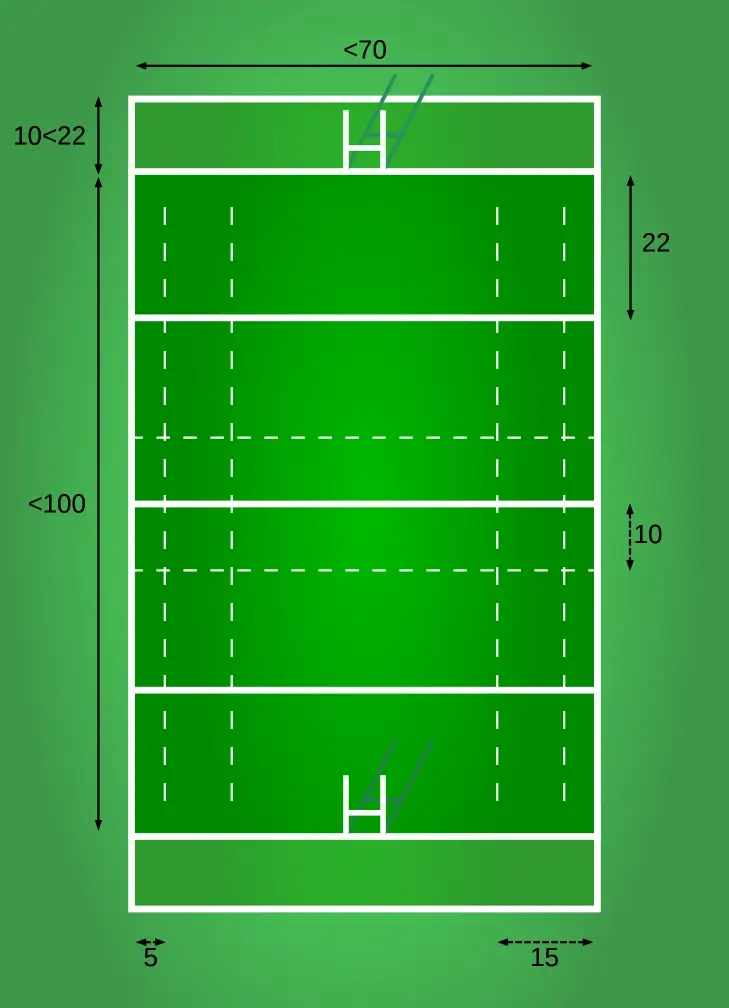5 الاختلافات بين الرجبي وقواعد كرة القدم الأسترالية
5 الاختلافات بين الرجبي وقواعد كرة القدم الأسترالية
مقدمة

Sports have perennially occupied a cherished space in the hearts of enthusiasts worldwide, serving as a unifying force for communities and instilling a profound sense of national pride. Within the vast spectrum of sports that captivate global audiences, rugby and Australian Rules Football stand out as iconic athletic pursuits. These two dynamic sports not only exemplify remarkable athleticism and strategic gameplay but also command substantial popularity and cultural significance in their respective regions.
A Tale of Two Sports: Rugby and Australian Rules Football
The narrative of rugby, often hailed as the quintessential collision sport, finds its roots in 19th-century England. Originating from traditional football games played in schools where ball handling was permissible, rugby underwent significant evolution, ultimately giving rise to two distinct codes: rugby union and rugby league.
اليوم, rugby is lauded for its tenacious spirit, intense physicality, strategic intricacies, and remarkable displays of skill. في المقابل, Australian Rules Football emerged on Australian soil in the mid-19th century, drawing inspiration from a blend of sports like Gaelic football, soccer, and rugby itself. Tailored to suit Australia’s climatic conditions, this sport has evolved into a unique code.
Renowned for its fast-paced action and high-scoring dynamics, Australian Rules Football showcases a fusion of skills. Players can score by kicking goals through goalposts or earning points through handballing or kicking the oval-shaped ball between two tall posts.
Pervasive Popularity with Cultural Significance
Rugby and Australian Rules Football have both amassed colossal followings, owing to their exhilarating gameplay and profound cultural relevance in their respective regions. Rugby has captivated audiences globally, boasting fervent fan bases in countries like New Zealand (home to the reigning world champions), أستراليا (especially with the formidable Wallabies), South Africa, and England. The sport has become synonymous with the identities of these nations, celebrated through prestigious international tournaments such as the Rugby World Cup.
قواعد كرة القدم الأسترالية, affectionately known as “Aussie Rules,” is deeply ingrained in the fabric of Australian society. It represents a national obsession, eliciting passionate support from dedicated fans across all states. The cultural significance of the sport resonates strongly, particularly during events like the Australian Football League (AFL) Grand Final, where hundreds of thousands gather in stadiums or tune in from home for this pinnacle clash. Aussie Rules encapsulates the essence of Australia’s sporting excellence and serves as a unifying force among communities nationwide.
As we delve deeper into the realms of these captivating sports—rugby and Australian Rules football—it becomes evident that their widespread popularity and cultural significance transcend mere athletic competition. They stand as symbols of heritage, pride, and unity, forging connections among people across borders and leaving an enduring impact on their respective societies.
Origins and History
Rugby: Tracing back to the 19th Century in England
Rugby: Dating back to 19th century England
Rugby is an English sport from the 19th century that is renowned for its physicality and strategic play. Its origins are in the classic school soccer game, to which Rugby School made a significant contribution.
When William Webb Ellis broke the then-current rules in a match at Rugby School by catching and running, rugby was born in 1823. As rugby gained popularity in British educational institutions over time, clubs and organized competitions formed. In 1871, the Rugby Football Union (RFU) was founded, marking a significant turning point in rugby history by unifying regional rules and establishing a standardized framework for play.
Due to the organization’s and the rules’ growing formalization, rugby developed from the traditional school game. The modern game of rugby was founded on a standardized set of laws that were produced by the combined efforts of various sporting bodies. After some time, conflicting opinions about the game caused the Rugby Football League and Rugby Union rules to separate.
Rugby Union and League: Differing Journeys
In 1895, disputes over player salaries resulted in the establishment of the Northern Rugby Football Union, which would eventually become known as Rugby League. With the introduction of player compensation and other rule changes, this new code gained traction among British working-class communities and eventually expanded worldwide.
Under the RFU’s direction, rugby union developed further in the interim, putting a strong emphasis on tradition and amateurism. The sport gained international recognition and became more organized.
قواعد كرة القدم الأسترالية: Emergence in Mid-19th Century Australia
قواعد كرة القدم الأسترالية, often referred to as footy or Aussie rules, emerged in mid-19th century Australia. Heavily influenced by sports imported from Britain, including Gaelic football, soccer, and rugby, it developed unique characteristics that set it apart. The exact moment of its inception is challenging to pinpoint due to gradual evolution, but organized games were played in Victoria by the 1850s.
Borrowing elements from different sports, Australian Rules Football fused them into a distinct style of play. Gaelic football contributed high marking and field positioning, soccer introduced goalposts and boundary lines, and rugby influenced aspects like goal-kicking and tackling techniques.
Unique Rules and Cultural Adaptations
As the sport spread across Australia, local communities developed unique rules to suit the landscape, climate, and cultural factors. Adaptations like bouncing the ball while running and playing on oval-shaped fields allowed for more fluid gameplay and strategic maneuvering. These adaptations reflected the physicality and athleticism of Australian players, shaping a distinct national sporting identity.
In delving into the origins and history of rugby and Australian Rules Football, we gain insights into their evolution, each marked by distinctive characteristics shaped by cultural influences and local conditions. Understanding these foundations provides a solid groundwork for exploring the gameplay, popularity, and impact of these beloved sports.
5 الاختلافات بين الرجبي وقواعد كرة القدم الأسترالية
When comparing Australian rules soccer and rugby, it is impossible to ignore the numerous differences between the two sports. These differences manifest themselves in many ways, including equipment and playing surfaces, scoring and playing rules, positions and styles of play, physical confrontation and contact, and their broad appeal.
1. Playing field and equipment


In the realm of rugby, the game is typically played on a rectangular field adorned with goalposts on each end. The dimensions of this field may vary, but it is usually around 100 meters in length and 70 meters in width. The goalposts, standing tall and resolute, are H-shaped and positioned at the center of each goal line. In stark contrast, Australian rules football unfolds on an oval-shaped field, often referred to as an “oval” أو “footy field.” The dimensions of this field can vary, but it is generally larger than its rugby counterpart. The goalposts in Australian rules football, standing tall and proud, are positioned at the center of each goal line, resembling an “upright Y” shape.


When it comes to the equipment employed in these sports, rugby players wield an oval-shaped ball crafted from leather or synthetic material. This ball, slightly larger than the football used in Australian rules football, takes center stage in the game. في المقابل, Australian rules football embraces an oval-shaped ball, also fashioned from leather or synthetic material, but smaller and rounder compared to its rugby counterpart.
2. Game rules and scoring

The world of rugby is governed by specific rules that dictate gameplay. These rules encompass various aspects, including the offside rule, the prohibition of forward passes, and the requirement to pass the ball backward. The scoring system in rugby encompasses a multitude of methods, such as tries, conversions, penalties, and drop goals. In the realm of Australian rules football, the rules grant players the freedom to kick, handball, and run with the ball. There is no offside rule to constrain their movements, and players can pass the ball in any direction they desire. Scoring in Australian rules football revolves around the art of kicking the ball through the goalposts, resulting in different point values contingent upon the method and location of the kick.
3. Playing style and positions


Rugby, renowned for its physicality, strategic prowess, and unwavering teamwork, is a game divided into two main styles: rugby union and rugby league. Within these styles, rugby positions are highly specialized, with players assigned to specific roles such as forwards, backs, and a plethora of positions nestled within those categories. Australian rules football, on the other hand, prides itself on its fast-paced, high-scoring nature. The game does not adhere to strict player positions, allowing participants to freely rotate and move across the field, unburdened by the constraints of designated roles.
One of the distinct elements of AFL is marking, where players jump and catch the ball before it hits the ground, often by leaping onto their opponents’ shoulders. This unique skill adds an element of spectacle and excitement to the sport.
In addition to marking, bouncing is another key element in AFL. Players must bounce the ball on the ground every few steps while running to maintain possession legally.
This adds a tactical dimension to the gameplay as players strategize when and where to bounce the ball while evading opponents. Running with the ball is also a crucial aspect of AFL.
Players can run with it for short distances before passing or kicking it to a teammate or attempting to score points themselves. This fluidity of movement combined with precision passing and accurate kicking makes Australian Rules Football an exhilarating spectacle for both players and spectators alike.
4. Physicality and contact

What’s the point of rugby without physical confrontation?
Both rugby and Australian rules football undoubtedly embrace physicality and contact, yet they diverge in terms of the nature of this contact. Rugby, renowned for its intense physicality, sees players engaging in tackles, scrums, and rucks. It demands a formidable display of tackling prowess and defensive skills. Australian rules football, on the other hand, incorporates physical contact with a different emphasis. The game revolves around the art of evading opponents through agility, marking the ball, and executing accurate kicks or handpasses. It necessitates a blend of athleticism and nimbleness.
5. Popularity and global reach
As for the realm of popularity and global reach, rugby reigns supreme. It enjoys a significant level of acclaim and global recognition, with the sport being played internationally and garnering a fervent following in countries such as New Zealand, أستراليا, England, South Africa, and countless others. The Rugby World Cup, a tournament of unparalleled prestige, stands as a testament to the sport’s global reach and influence. Australian rules football, on the other hand, thrives predominantly within the borders of Australia. It boasts a dedicated following and is played at both amateur and professional levels throughout the country, with the Australian Football League (AFL) serving as the premier competition. While its popularity remains primarily concentrated in Australia, there exist small communities of Australian rules football enthusiasts scattered across the globe.
خاتمة
In the comparison of rugby and Australian Rules Football, we observe two sports that have attained remarkable popularity within their respective realms. Rugby, with its thrilling matches and globally acclaimed tournaments such as the Rugby World Cup, has garnered a widespread following, captivating audiences on an international scale. On the other hand, Australian Rules Football has seamlessly woven itself into the fabric of Australian identity, creating profound community bonds and capturing the essence of the nation’s spirit.
Both sports serve as powerful unifiers, bringing people together through a harmonious blend of athleticism, strategy, and teamwork. Whether it’s the vibrant atmosphere in Australian stadiums or the global spectacle of rugby’s grandest tournaments, these sports exemplify the ability of sport to transcend borders and foster connections among diverse communities.
Delving into the worlds of rugby and Australian Rules Football, we are reminded of sports’ incredible capacity to unite people under a shared passion while celebrating diversity. Let us embrace these vibrant sporting cultures with open arms as they persist in inspiring future generations on their journeys toward excellence—both on and off the field.
الأعمال أمامه
5 الاختلافات بين الرجبي وقواعد كرة القدم الأسترالية
مقدمة

Sports have perennially occupied a cherished space in the hearts of enthusiasts worldwide, serving as a unifying force for communities and instilling a profound sense of national pride. Within the vast spectrum of sports that captivate global audiences, rugby and Australian Rules Football stand out as iconic athletic pursuits. These two dynamic sports not only exemplify remarkable athleticism and strategic gameplay but also command substantial popularity and cultural significance in their respective regions.
A Tale of Two Sports: Rugby and Australian Rules Football
The narrative of rugby, often hailed as the quintessential collision sport, finds its roots in 19th-century England. Originating from traditional football games played in schools where ball handling was permissible, rugby underwent significant evolution, ultimately giving rise to two distinct codes: rugby union and rugby league.
اليوم, rugby is lauded for its tenacious spirit, intense physicality, strategic intricacies, and remarkable displays of skill. في المقابل, Australian Rules Football emerged on Australian soil in the mid-19th century, drawing inspiration from a blend of sports like Gaelic football, soccer, and rugby itself. Tailored to suit Australia’s climatic conditions, this sport has evolved into a unique code.
Renowned for its fast-paced action and high-scoring dynamics, Australian Rules Football showcases a fusion of skills. Players can score by kicking goals through goalposts or earning points through handballing or kicking the oval-shaped ball between two tall posts.
Pervasive Popularity with Cultural Significance
Rugby and Australian Rules Football have both amassed colossal followings, owing to their exhilarating gameplay and profound cultural relevance in their respective regions. Rugby has captivated audiences globally, boasting fervent fan bases in countries like New Zealand (home to the reigning world champions), أستراليا (especially with the formidable Wallabies), South Africa, and England. The sport has become synonymous with the identities of these nations, celebrated through prestigious international tournaments such as the Rugby World Cup.
قواعد كرة القدم الأسترالية, affectionately known as “Aussie Rules,” is deeply ingrained in the fabric of Australian society. It represents a national obsession, eliciting passionate support from dedicated fans across all states. The cultural significance of the sport resonates strongly, particularly during events like the Australian Football League (AFL) Grand Final, where hundreds of thousands gather in stadiums or tune in from home for this pinnacle clash. Aussie Rules encapsulates the essence of Australia’s sporting excellence and serves as a unifying force among communities nationwide.
As we delve deeper into the realms of these captivating sports—rugby and Australian Rules football—it becomes evident that their widespread popularity and cultural significance transcend mere athletic competition. They stand as symbols of heritage, pride, and unity, forging connections among people across borders and leaving an enduring impact on their respective societies.
Origins and History
Rugby: Tracing back to the 19th Century in England
Rugby: Dating back to 19th century England
Rugby is an English sport from the 19th century that is renowned for its physicality and strategic play. Its origins are in the classic school soccer game, to which Rugby School made a significant contribution.
When William Webb Ellis broke the then-current rules in a match at Rugby School by catching and running, rugby was born in 1823. As rugby gained popularity in British educational institutions over time, clubs and organized competitions formed. In 1871, the Rugby Football Union (RFU) was founded, marking a significant turning point in rugby history by unifying regional rules and establishing a standardized framework for play.
Due to the organization’s and the rules’ growing formalization, rugby developed from the traditional school game. The modern game of rugby was founded on a standardized set of laws that were produced by the combined efforts of various sporting bodies. After some time, conflicting opinions about the game caused the Rugby Football League and Rugby Union rules to separate.
Rugby Union and League: Differing Journeys
In 1895, disputes over player salaries resulted in the establishment of the Northern Rugby Football Union, which would eventually become known as Rugby League. With the introduction of player compensation and other rule changes, this new code gained traction among British working-class communities and eventually expanded worldwide.
Under the RFU’s direction, rugby union developed further in the interim, putting a strong emphasis on tradition and amateurism. The sport gained international recognition and became more organized.
قواعد كرة القدم الأسترالية: Emergence in Mid-19th Century Australia
قواعد كرة القدم الأسترالية, often referred to as footy or Aussie rules, emerged in mid-19th century Australia. Heavily influenced by sports imported from Britain, including Gaelic football, soccer, and rugby, it developed unique characteristics that set it apart. The exact moment of its inception is challenging to pinpoint due to gradual evolution, but organized games were played in Victoria by the 1850s.
Borrowing elements from different sports, Australian Rules Football fused them into a distinct style of play. Gaelic football contributed high marking and field positioning, soccer introduced goalposts and boundary lines, and rugby influenced aspects like goal-kicking and tackling techniques.
Unique Rules and Cultural Adaptations
As the sport spread across Australia, local communities developed unique rules to suit the landscape, climate, and cultural factors. Adaptations like bouncing the ball while running and playing on oval-shaped fields allowed for more fluid gameplay and strategic maneuvering. These adaptations reflected the physicality and athleticism of Australian players, shaping a distinct national sporting identity.
In delving into the origins and history of rugby and Australian Rules Football, we gain insights into their evolution, each marked by distinctive characteristics shaped by cultural influences and local conditions. Understanding these foundations provides a solid groundwork for exploring the gameplay, popularity, and impact of these beloved sports.
5 الاختلافات بين الرجبي وقواعد كرة القدم الأسترالية
When comparing Australian rules soccer and rugby, it is impossible to ignore the numerous differences between the two sports. These differences manifest themselves in many ways, including equipment and playing surfaces, scoring and playing rules, positions and styles of play, physical confrontation and contact, and their broad appeal.
1. Playing field and equipment


In the realm of rugby, the game is typically played on a rectangular field adorned with goalposts on each end. The dimensions of this field may vary, but it is usually around 100 meters in length and 70 meters in width. The goalposts, standing tall and resolute, are H-shaped and positioned at the center of each goal line. In stark contrast, Australian rules football unfolds on an oval-shaped field, often referred to as an “oval” أو “footy field.” The dimensions of this field can vary, but it is generally larger than its rugby counterpart. The goalposts in Australian rules football, standing tall and proud, are positioned at the center of each goal line, resembling an “upright Y” shape.


When it comes to the equipment employed in these sports, rugby players wield an oval-shaped ball crafted from leather or synthetic material. This ball, slightly larger than the football used in Australian rules football, takes center stage in the game. في المقابل, Australian rules football embraces an oval-shaped ball, also fashioned from leather or synthetic material, but smaller and rounder compared to its rugby counterpart.
2. Game rules and scoring

The world of rugby is governed by specific rules that dictate gameplay. These rules encompass various aspects, including the offside rule, the prohibition of forward passes, and the requirement to pass the ball backward. The scoring system in rugby encompasses a multitude of methods, such as tries, conversions, penalties, and drop goals. In the realm of Australian rules football, the rules grant players the freedom to kick, handball, and run with the ball. There is no offside rule to constrain their movements, and players can pass the ball in any direction they desire. Scoring in Australian rules football revolves around the art of kicking the ball through the goalposts, resulting in different point values contingent upon the method and location of the kick.
3. Playing style and positions


Rugby, renowned for its physicality, strategic prowess, and unwavering teamwork, is a game divided into two main styles: rugby union and rugby league. Within these styles, rugby positions are highly specialized, with players assigned to specific roles such as forwards, backs, and a plethora of positions nestled within those categories. Australian rules football, on the other hand, prides itself on its fast-paced, high-scoring nature. The game does not adhere to strict player positions, allowing participants to freely rotate and move across the field, unburdened by the constraints of designated roles.
One of the distinct elements of AFL is marking, where players jump and catch the ball before it hits the ground, often by leaping onto their opponents’ shoulders. This unique skill adds an element of spectacle and excitement to the sport.
In addition to marking, bouncing is another key element in AFL. Players must bounce the ball on the ground every few steps while running to maintain possession legally.
This adds a tactical dimension to the gameplay as players strategize when and where to bounce the ball while evading opponents. Running with the ball is also a crucial aspect of AFL.
Players can run with it for short distances before passing or kicking it to a teammate or attempting to score points themselves. This fluidity of movement combined with precision passing and accurate kicking makes Australian Rules Football an exhilarating spectacle for both players and spectators alike.
4. Physicality and contact

What’s the point of rugby without physical confrontation?
Both rugby and Australian rules football undoubtedly embrace physicality and contact, yet they diverge in terms of the nature of this contact. Rugby, renowned for its intense physicality, sees players engaging in tackles, scrums, and rucks. It demands a formidable display of tackling prowess and defensive skills. Australian rules football, on the other hand, incorporates physical contact with a different emphasis. The game revolves around the art of evading opponents through agility, marking the ball, and executing accurate kicks or handpasses. It necessitates a blend of athleticism and nimbleness.
5. Popularity and global reach
As for the realm of popularity and global reach, rugby reigns supreme. It enjoys a significant level of acclaim and global recognition, with the sport being played internationally and garnering a fervent following in countries such as New Zealand, أستراليا, England, South Africa, and countless others. The Rugby World Cup, a tournament of unparalleled prestige, stands as a testament to the sport’s global reach and influence. Australian rules football, on the other hand, thrives predominantly within the borders of Australia. It boasts a dedicated following and is played at both amateur and professional levels throughout the country, with the Australian Football League (AFL) serving as the premier competition. While its popularity remains primarily concentrated in Australia, there exist small communities of Australian rules football enthusiasts scattered across the globe.
خاتمة
In the comparison of rugby and Australian Rules Football, we observe two sports that have attained remarkable popularity within their respective realms. Rugby, with its thrilling matches and globally acclaimed tournaments such as the Rugby World Cup, has garnered a widespread following, captivating audiences on an international scale. On the other hand, Australian Rules Football has seamlessly woven itself into the fabric of Australian identity, creating profound community bonds and capturing the essence of the nation’s spirit.
Both sports serve as powerful unifiers, bringing people together through a harmonious blend of athleticism, strategy, and teamwork. Whether it’s the vibrant atmosphere in Australian stadiums or the global spectacle of rugby’s grandest tournaments, these sports exemplify the ability of sport to transcend borders and foster connections among diverse communities.
Delving into the worlds of rugby and Australian Rules Football, we are reminded of sports’ incredible capacity to unite people under a shared passion while celebrating diversity. Let us embrace these vibrant sporting cultures with open arms as they persist in inspiring future generations on their journeys toward excellence—both on and off the field.
نبذة عن المؤلف

مرحبا بكم في مدونتنا! اسمي بيتر وأنا المؤلف الرئيسي لهذه المدونة. كممارس للتعافي الرياضي وله اهتمامات وخبرة عميقة.
أنا ملتزم بتقديم المفاهيم المعقدة بطريقة واضحة وموجزة, وتمكين القراء من فهم تلك المعرفة وتطبيقها بشكل أفضل من خلال البحث المتعمق وتبادل الخبرات.
شكرا لقراءتك ودعمك! إذا كان لديك أسئلة أو اقتراحات حول أي من المحتوى, لا تتردد في الاتصال بي. وإنني أتطلع إلى مشاركة المزيد من المعلومات المثيرة للاهتمام والمفيدة معك والنمو معًا في هذه الرحلة المعرفية!
